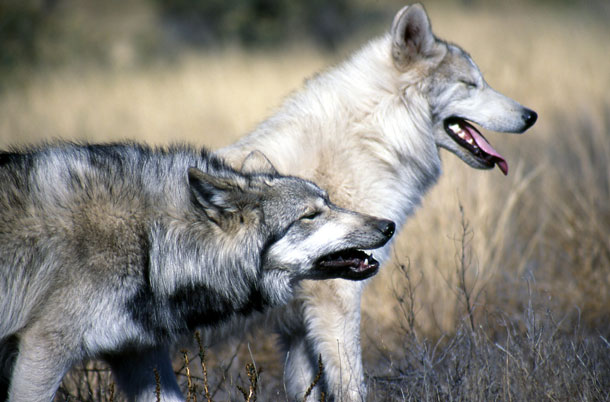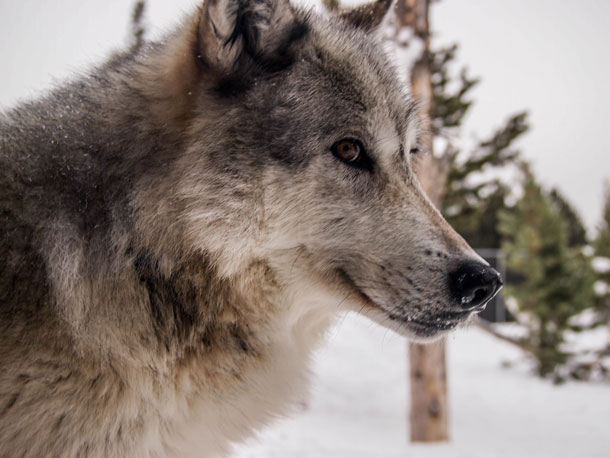Winter Wolves on the Move
Air Date: Week of November 22, 2019

Since gray wolves hunt in packs, they are able to take down prey as large as elks. (Photo: Caninest, Flickr, Public Domain)
The Lamar Valley is one of the best spots in Yellowstone National Park to see and hear its iconic gray wolves. As the snow begins to fall, they’re on the hunt in this essay from Living on Earth’s Explorer in Residence, Mark Seth Lender.
Transcript
CURWOOD: Living on Earth’s explorer in residence Mark Seth Lender headed out into the snows of Yellowstone to see and hear the wolves for himself.
The Sporting Life
Grey Wolves, Lamar Valley
© 2017 Mark Seth Lender
All Rights Reserved.
Leaping and loping, tongues lolling, the snow falling, their great paws snow plowing, down the slope they come. Toward the level ground. Down, and down. They are early. The sun hidden below the mountains. The snow blue. The sky blue black. The stillness pure, white. Down. And down.
Trotting now in their dog-like way along the bank they go. Above where the river flows. Past where elk have nibbled the alder to a stubble, and the land in a blanket of winter ten feet deep.
The river is iced over. It is a bridge across the valley they do not cross but turn, to the westward and the low hills, away from the frozen flow.

An American Gray wolf in West Yellowstone, Montana. (Photo: Patrick Carlson, Flickr, CC BY-NC 2.0)
And are hidden...
And appear again...
And into the rolling contours of the land - and gone:
Grey wolves, hunting!
The next day beside the ice where the wolves where last seen, an elk stands by himself, antlers five feet across, his lines, his stature; he could be cast in bronze. Except that he moves. He turns his head and looks at the hind part of him, at what the wolves have done to him.
The pack lolls nearby. They are in a hollow just above the river. Sleeping and waking and stretching, and going back to sleep. They imply no desire to do anything else. But in their winter-thick coats in an hour the sun becomes uncomfortable and they mill about, and on some indiscernible signal begin to howl, all together, confirming to each other their order and unity. A young wolf in need of additional teaching is nipped and knocked over and he yelps and cries but is unharmed. And the wolves leave.
They have no intention of finishing what they started. Which does not enhance their reputation. But they cannot help it. The consequence of too many elk there for the taking.
They are too much like us for their own good.
CURWOOD: Living on Earth’s Mark Seth Lender. Our wolf sounds from Yellowstone were produced by Jennifer Jarret.
Links
Living on Earth wants to hear from you!
Living on Earth
62 Calef Highway, Suite 212
Lee, NH 03861
Telephone: 617-287-4121
E-mail: comments@loe.org
Newsletter [Click here]
Donate to Living on Earth!
Living on Earth is an independent media program and relies entirely on contributions from listeners and institutions supporting public service. Please donate now to preserve an independent environmental voice.
NewsletterLiving on Earth offers a weekly delivery of the show's rundown to your mailbox. Sign up for our newsletter today!
 Sailors For The Sea: Be the change you want to sea.
Sailors For The Sea: Be the change you want to sea.
 The Grantham Foundation for the Protection of the Environment: Committed to protecting and improving the health of the global environment.
The Grantham Foundation for the Protection of the Environment: Committed to protecting and improving the health of the global environment.
 Contribute to Living on Earth and receive, as our gift to you, an archival print of one of Mark Seth Lender's extraordinary wildlife photographs. Follow the link to see Mark's current collection of photographs.
Contribute to Living on Earth and receive, as our gift to you, an archival print of one of Mark Seth Lender's extraordinary wildlife photographs. Follow the link to see Mark's current collection of photographs.
 Buy a signed copy of Mark Seth Lender's book Smeagull the Seagull & support Living on Earth
Buy a signed copy of Mark Seth Lender's book Smeagull the Seagull & support Living on Earth

